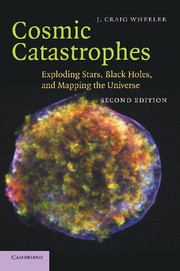Book contents
- Frontmatter
- Contents
- Preface
- 1 Setting the stage: star formation and hydrogen burning in single stars
- 2 Stellar death: the inexorable grip of gravity
- 3 Dancing with stars: binary stellar evolution
- 4 Accretion disks: flat stars
- 5 White dwarfs: quantum dots
- 6 Supernovae: stellar catastrophes
- 7 Supernova 1987A: lessons and enigmas
- 8 Neutron stars: atoms with attitude
- 9 Black holes in theory: into the abyss
- 10 Black holes in fact: exploring the reality
- 11 Gamma-ray bursts, black holes and the Universe: long, long ago and far, far away
- 12 Supernovae and the Universe
- 13 Wormholes and time machines: tunnels in space and time
- 14 Beyond: the frontiers
- Index
12 - Supernovae and the Universe
Published online by Cambridge University Press: 14 September 2009
- Frontmatter
- Contents
- Preface
- 1 Setting the stage: star formation and hydrogen burning in single stars
- 2 Stellar death: the inexorable grip of gravity
- 3 Dancing with stars: binary stellar evolution
- 4 Accretion disks: flat stars
- 5 White dwarfs: quantum dots
- 6 Supernovae: stellar catastrophes
- 7 Supernova 1987A: lessons and enigmas
- 8 Neutron stars: atoms with attitude
- 9 Black holes in theory: into the abyss
- 10 Black holes in fact: exploring the reality
- 11 Gamma-ray bursts, black holes and the Universe: long, long ago and far, far away
- 12 Supernovae and the Universe
- 13 Wormholes and time machines: tunnels in space and time
- 14 Beyond: the frontiers
- Index
Summary
OUR EXPANDING UNIVERSE
Distant galaxies, those so far away that, unlike the Magellanic Clouds, or our sister spiral Andromeda, we do not not sense their individual gravities, are moving away from us. Their speed is nearly proportional to their distance. One can get this effect by setting off a bomb. The faster fragments get further away in a given amount of time so, at a later instant, the faster fragments are further away with a distance that depends linearly on the speed. This, Einstein has taught us, is not how the Universe works. The bomb analogy requires there to be a preexisting space, independent of the matter in the “bomb,” into which the bomb explodes. Einstein has taught us, as we explored in Chapter 9, that space is a curving, dynamical entity that is shaped by the gravitating matter within it. Preexisting empty space with a bomb in the center makes no sense mathematically or conceptually in Einstein's Universe.
Rather, Einstein taught us that space itself can expand, carrying the essentially motionless galaxies apart. In this manner, all distant galaxies, those that do not share an immediate gravitational grip, move away from all others. There is no center of the explosion. The fact that we see all distant galaxies moving away from us is an effect created by the uniform expansion of space. With some thought, you can convince yourself that the apparent speed with which galaxies recede depends linearly on the distance, just as observed.
- Type
- Chapter
- Information
- Cosmic CatastrophesExploding Stars, Black Holes, and Mapping the Universe, pp. 263 - 285Publisher: Cambridge University PressPrint publication year: 2007



